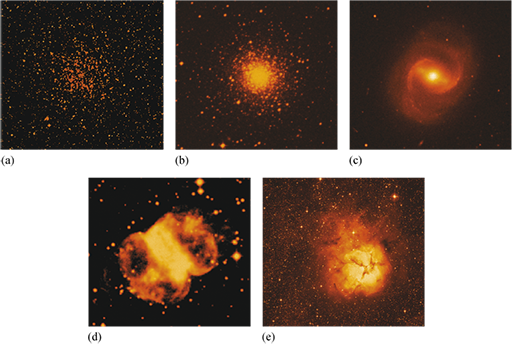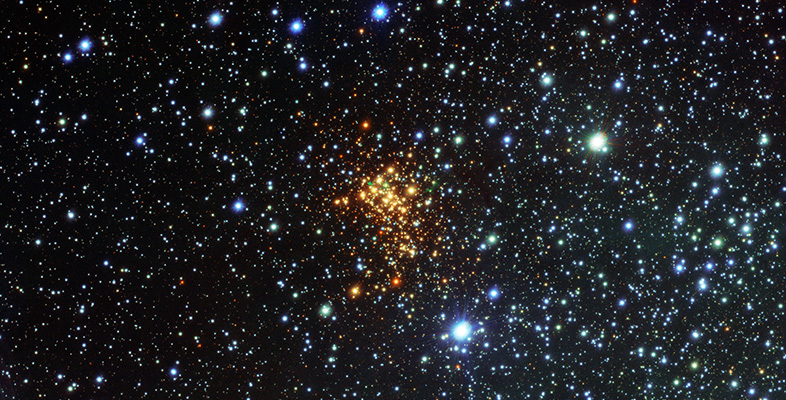2.3 Types of extended objects
In your research for Activity 1, you will have probably come across several different types of extended objects. Optical astronomers now recognise five main classes of deep-sky object, shown in Figure 9. Here you will consider each of these in turn, focusing on the image structure they show.

Open cluster
Figure 9a shows M11, an example of an open cluster of stars. With modern telescopes, you can make out individual stars in the cluster, but at low image resolution the light from the stars blurs together to form a fuzzy, nebula-like appearance.
Globular cluster
Figure 9b shows M75, a globular cluster. Like M11 this is a collection of many stars, but its spatial structure is different. This cluster has a round shape and more regular appearance, and it is brighter in the centre and fainter at the edges. The stars are packed closely together in the cluster centre but are more spread out at larger distances.
Galaxy
Figure 9c shows M91, which is a galaxy. Like M11 and M75, M91 is a collection of stars, but its structure is very different. We cannot identify individual stars, but you can see a spiral structure. The smooth, diffuse nature of the light tells us that it comes from a much larger number of stars than is the case for star clusters.
Planetary nebula
This class of nebulae show extremely diverse structures – the example in Figure 9d is M76 (the Little Dumbbell nebula). Planetary nebulae have nothing to do with planets; they are the debris of a Sun-like star that has reached the end of its life. The name comes from their coloured, disc-like appearance in early images.
Some planetary nebulae have round circularly symmetric structures, while others are ‘bipolar’, showing butterfly-like linear symmetry.
Diffuse nebula
Figure 9e shows M20, an example of a diffuse nebula. This final category encompasses objects where images show a smooth light distribution not made up of individual stars, which is less regular in structure than the planetary nebulae. The light from diffuse nebulae comes from warm, glowing gas and dust associated with star-forming regions.
In the next activity, you will further compare these examples of the five types of extended objects.
Activity 2 Comparing the scales of Messier objects
The Scales Tool plots the sizes and distances of all the Messier catalogue objects, including the five Messier objects shown in Figure 9 (M11, M75, M91, M76 and M20).
Use the tool to investigate the properties of the five objects from Figure 9 and to determine the following information. Note that it is likely to be helpful to use the ‘Messier object types’ key at the top to show only the relevant categories of object when searching for a particular Messier object on the distance–size graph.
- a.List the five objects in order from smallest to largest, and then again from nearest to most distant.
- b.Note how much larger the largest of these Messier objects is than the smallest.
- c.Note how much further away the most distant of the objects is than the nearest.
- d.Find the Messier object you studied in Activity 1, and note how it compares to the five in Figure 9.
Discussion
- a.Smallest to largest: M76, M11, M20, M75, M91 (planetary nebulae are larger than stars, but typically smaller than diffuse nebulae and star clusters, which in turn are much smaller than galaxies). Nearest to most distant: M76, M20, M11, M75, M91.
- b.The Messier objects span a very wide range of sizes. The largest object, the galaxy M91, is around 35 000 times larger than the smallest, M76.
- c.M91 is also the most distant of the objects in Figure 9, and M76 is the nearest. M91 is around 19 000 times more distant than M76.
- d.Your findings will depend on your choice of Messier object, but this activity should have given you a sense of the varied sizes and appearances of extended objects in the night sky.
